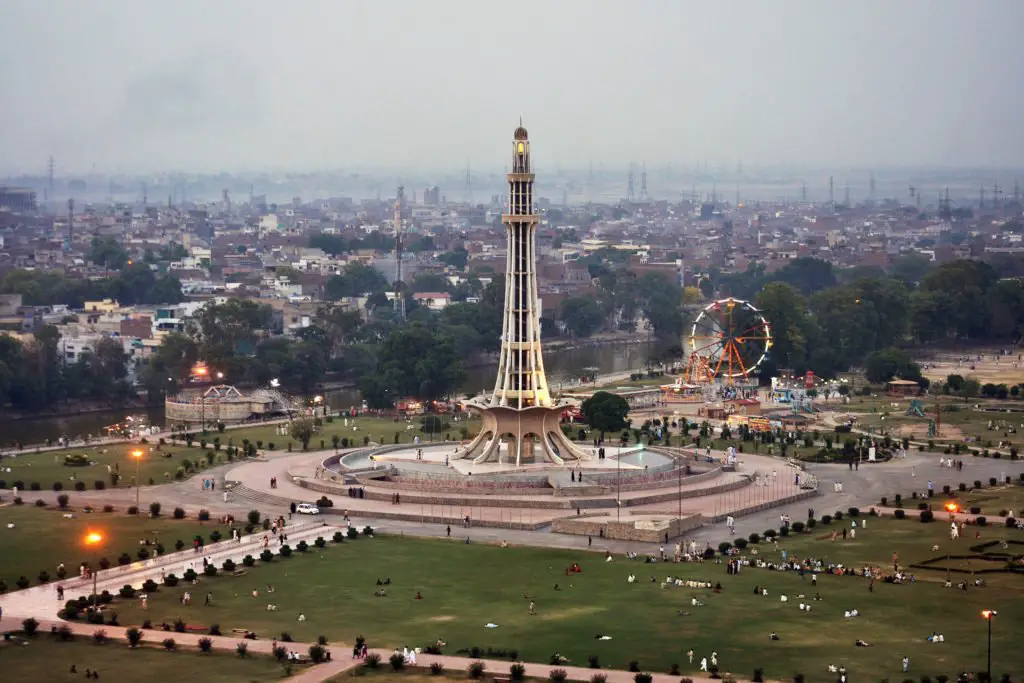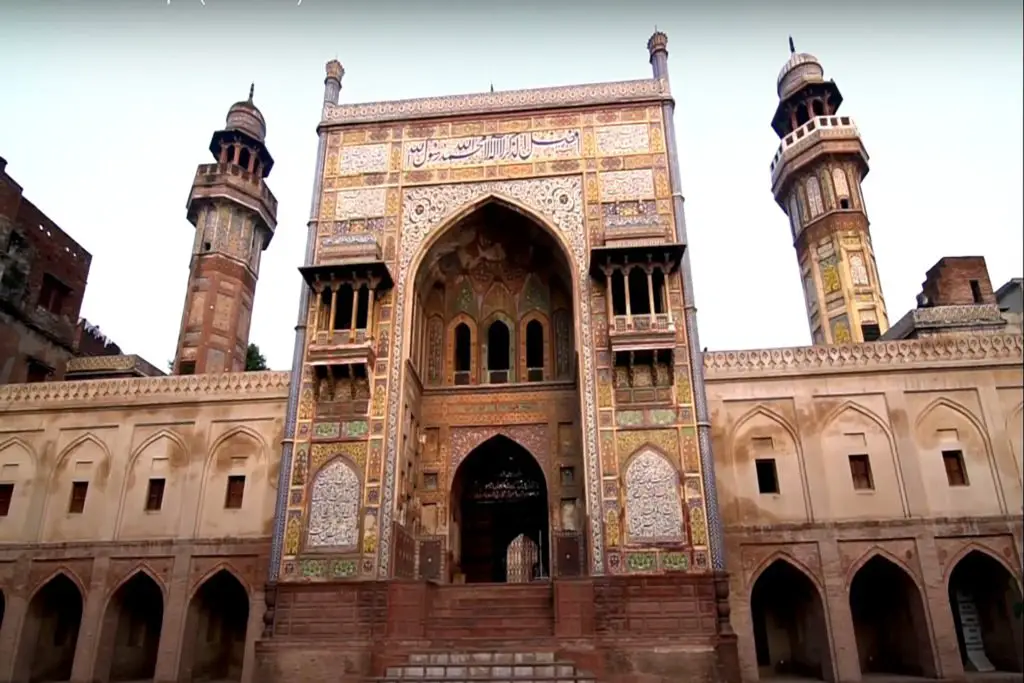Minar e Pakistan in Lahore is a historical monument. It is considered as the most important tower in Pakistan. Minar e Pakistan is the vicinity where the Lahore resolution was passed, which became the legit name for a separate native land for the Muslims of South Asia based on the two nations theory.
Minar e Pakistan in Lahore also known as the “Tower of Pakistan” is an open landmark located in Iqbal Park in Lahore, Pakistan. The tower was constructed all through the Sixties at the site wherein, on 23 March 1940, the All-India Muslim League surpassed the Lahore resolution, the first official name for the Muslims dwelling in South Asia, as in step with the 2 nations’ idea, i.e. Hindus and Muslims living in Sub-Continent. The tower displays a mix of Mughal, Islamic, and present-day structural engineering.
Minar e Pakistan in Lahore also referred to as the ‘Tower of Pakistan,’ is known as the main Monument and laying stone for the Movement of a Separate Country namely Pakistan. Qarardad-e-Pakistan or Pakistan Resolution was founded in an All-India Muslim League convention on March 23, 1940. This assembly occurred at Minto Park – now it’s miles known as Iqbal Park.
History of Minar e Pakistan in Lahore
Minare I Pakistan Lahore is a famous and historical spot in Pakistan. Minar e Pakistan in Lahore was built at the place where the memorable Pakistan decision was supported by way of the All India Muslim League driven through Muhammad Ali Jinnah and other renowned political leaders of All India Muslim League, on March 3, 1940. It is also called as Yadgar of Pakistan. This spot was called Minto Park, which changed into Minar e Pakistan after the British Empire. These days this park is known as Iqbal Park.
Minar-e-Pakistan is vital due to its historical importance. There are some other spots for tourist attractions in the vicinity, for instance, Shahi Qila and Badshahi Masjid are also located nearby.
Minar E Pakistan Design
The base of Minar e Pakistan is eight meters above the floor. The tower ascents around sixty-two meters, along these traces the minaret is within 92 meters above the ground. The unfolding petals of the bloom-like base are nine meters. The breadth of the tower is something around seventy-five meters.
The platform Minar I Pakistan is constructed of designed tiles and faces the Badshahi Mosque. The base entails 4 tiers. The first stage is constructed with uncut Taxila stones, the second stage is made of mallet-dressed stones, and while third level is of chiselled stones. Cleaned white marble on the fourth and final stage delineates the triumph of the Pakistan Movement of 1940.
At the base, there are botanical engravings on ten focalizing white marble Commemorative plaques. The engravings include the content of the Lahore Resolution in Urdu, Bengali, and English language.
On different plaques, Quranic verses and 99 names of Almighty ALLAH are engraved in Arabic calligraphy, and some selections from the speeches of Muhammad Ali Jinnah (Founder of Pakistan), in Urdu, Bengali, and English, and also couplets of Allama Iqbal are inscribed.
With the improvement of the Metropolis and the convergence of Circular Road and Multan Avenue, air pollution is harming the marble structure that’s presently in need of maintenance.
Pakistan Movement Resolution was supported by Sardar Aurangzeb Khan from N.W.F.P., Zafar Ali Khan from Punjab, Chaudhry Khaliq-uz-Zamaan from United Provinces, Qazi Muhammad Essa from Balochistan, and Sir Abdullah Haroon from Sindh.
The Lahore Resolution presented an alternative vision for the aspirations of the Muslim population in British-controlled India, seeking to establish a separate state. This pursuit of an independent nation persisted over the subsequent seven years, ultimately leading to the birth of Pakistan on August 14, 1947, marked by significant sacrifices and a massive migration of people.
Location of Minar e Pakistan in Lahore
Minar I Pakistan, located within Iqbal Park at the intersection of Circular and Multan Road in Lahore, is a prominent landmark. It is surrounded by a public park that is open to visitors at all times and features artificial landscapes like mountains and lakes, adding to its allure. This location greatly enhances the beauty of the area and is highly recommended for a visit.
To commemorate the historic passing of the Pakistan Resolution, a tower was erected in Iqbal Park, with the foundation stone laid on March 23, 1960. It took eight years to complete the construction of this iconic structure in Lahore.
Designed by the Turkish architect Naseer ud Din, construction work began on March 23, 1960, and was successfully concluded on October 21, 1968. The total cost of building Minar e Pakistan in Lahore amounted to Rs. 75 lakhs.
Area of Minar e Pakistan in Lahore
Minar I Pakistan, situated on an expansive 18-acre area in Lahore, stands at a towering height of 196.5 feet. To reach its pinnacle, one must ascend 324 steps, although an advanced elevator has been added for convenience.
The lower portion of the tower is designed in a manner resembling the petals of a flower. On the marble façade of the tower, you can find verses from the Holy Quran, quotes from Muhammad Ali Jinnah and Allama Iqbal, and a brief history of the Muslim struggle for independence. Additionally, there is a representation of Pakistan’s objectives inscribed on its walls in both Urdu and Bengali languages.
The remarkable calligraphy work at Minar e Pakistan in Lahore was executed by renowned artists such as Hafiz Muhammad Yousaf, Sufi Khursheed Alam, Muhammad Sadiq Almas, Ibn e Parveen Raqam, and Muhammad Iqbal.
At the top of the tower, you will find the mausoleum of Hafeez Jalandhari, the composer of Pakistan’s national anthem. Surrounding the tower, there are beautiful gardens, fountains, and a serene lake. On June 3, 1984, the Lahore Development Authority (LDA) took control of Minar e Pakistan.
The total construction cost for this project was approximately PKR 7,058,000. To secure funds for the project, additional taxes were imposed, including levies on cinema tickets and passes for horse racing events, as resources were insufficient, and this was done at the request of Governor West Pakistan, Akhtar Hussain.
Height of Minar e Pakistan in Lahore
Minar-e-Pakistan has a height of 70 meters.
The design of Minar-e-Pakistan is a captivating blend of Mughal, Islamic, and modern architectural elements. This unique design was conceptualized by the talented architect, Mr. Naseer-ud-Din Murat Khan.
The architectural execution was overseen by Mr. Abdur Rehman Khan Niazi, a structural engineer, while the construction itself was carried out by Mian Abdul Khaliq. The construction process was completed in 1968. The tower’s design allows visitors to enjoy panoramic views of the entire city from its summit.
This aesthetically pleasing landmark stands 70 meters tall above the ground and is shaped like a flower. Its base, which is around 8 meters above the ground, consists of four levels. Each level symbolizes the various challenges and stages that people went through in their struggle for independence. The fourth level is adorned with white marble, showcasing the success of the Pakistani movement. Minar-e-Pakistan in Lahore is surrounded by picturesque parks and natural beauty.
There are numerous other attractions in close proximity to Minar-e-Pakistan that captivate tourists, such as the Badshahi Mosque, Lahore Fort, Wazir Khan Mosque, and many more.
Yadgar Pakistan is an excellent place to visit with your family, especially if you value historical significance. It rejuvenates your spirit and instills a deep sense of pride and love for Pakistan and its great leaders. It leaves a lasting impression, demonstrating that significant achievements result from taking small steps and not giving up.







